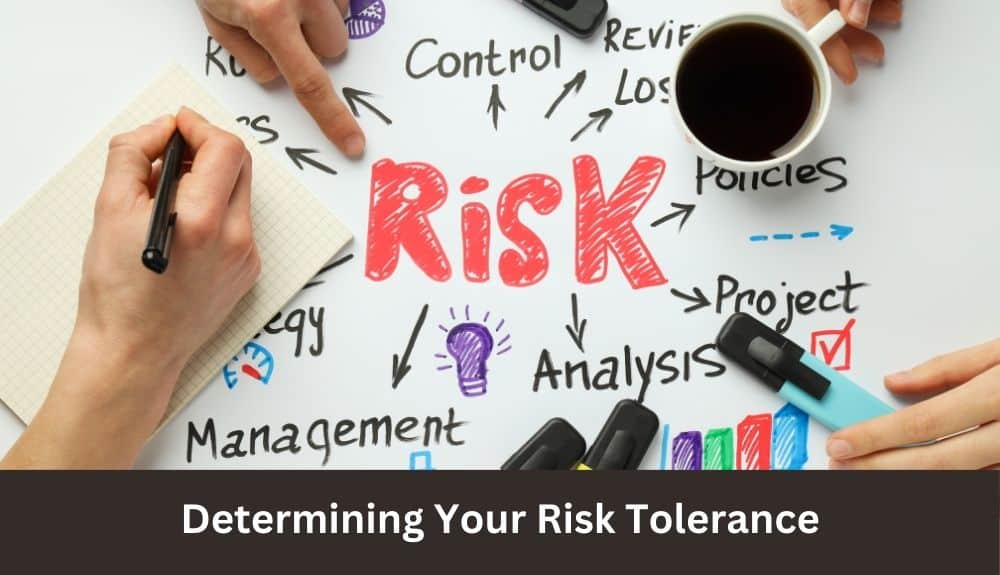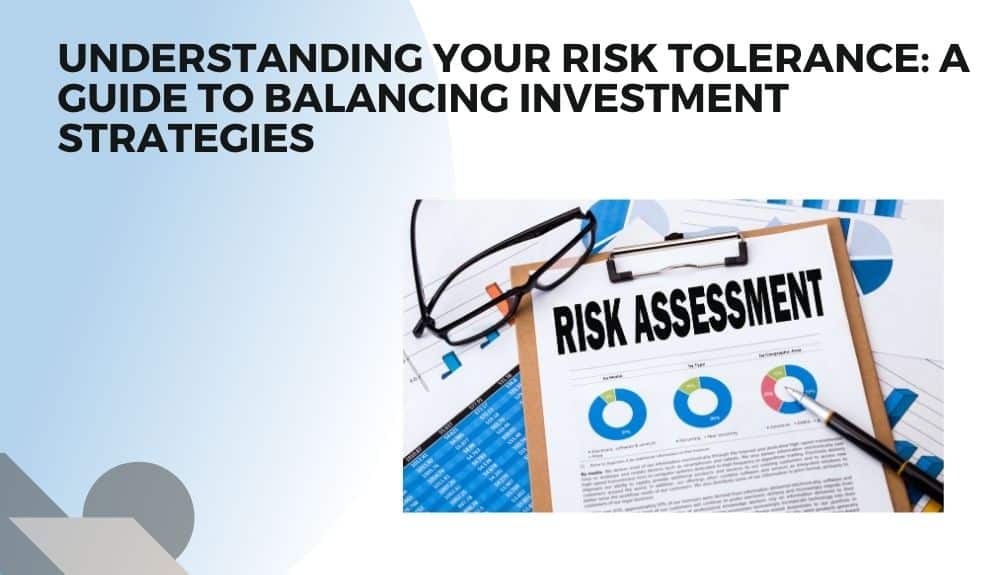Are you struggling to find the right balance between risk and reward in your investment strategies? Imagine navigating the complex world of investing with confidence, knowing exactly how much risk you can tolerate while aiming for your financial goals. Understanding your risk tolerance is not just about numbers; it’s about aligning your investments with your comfort level and long-term objectives.
In this comprehensive guide, we delve into the core concept of risk tolerance and its critical role in making informed investment decisions. From assessing your personal risk appetite to crafting a diversified portfolio that suits your unique needs, we provide expert insights and practical strategies to help you navigate the ever-evolving landscape of financial planning. Let’s explore how you can leverage your risk tolerance to optimize your investment journey, ensuring a secure financial future with the right balance of risk and return.
Introduction to Risk Tolerance
Understanding your risk tolerance is a crucial aspect of making informed investment decisions. Risk tolerance refers to an individual’s ability and willingness to withstand fluctuations in investment values. It plays a significant role in shaping investment strategies and determining the appropriate level of risk for achieving financial goals.
In the world of investing, risk and return tend to go hand in hand. Higher-risk investments have the potential for greater returns, but they also come with increased volatility. On the other hand, lower-risk investments offer stability but may yield lower returns.
The aim of this article is to provide insights into the concept of risk tolerance and emphasize its importance in investment decision-making. By gaining a deeper understanding of risk tolerance, you will be better equipped to evaluate your own investment preferences and align them with suitable strategies. Whether you have a conservative, moderate, or aggressive risk tolerance, this article will guide you towards finding the balance that suits your financial goals.
Remember, understanding your risk tolerance is a crucial step towards achieving investment success. So let’s delve into the world of risk tolerance and explore how it shapes investment strategies for a diverse range of investors.
What Is Risk Tolerance?
Risk tolerance plays a pivotal role in investment planning and decision-making. It refers to your comfort level and willingness to accept potential loss or volatility in pursuit of higher investment returns. Understanding your risk tolerance is essential as it sets the foundation for developing a suitable investment strategy that aligns with your financial goals and personal circumstances.
When determining your risk tolerance, several factors come into play. Each individual has a unique set of circumstances and preferences that shape their willingness to take on risk. Here are some key factors that influence risk tolerance:
1. Financial Goals: Your short-term and long-term financial objectives greatly impact your risk tolerance. If your goal is to preserve capital or mitigate risk, you may have a more conservative risk tolerance. Conversely, if you’re seeking aggressive growth, you might be comfortable with a higher degree of risk.
2. Time Horizon: The length of time you have to invest also affects your risk tolerance. If you have a longer time horizon, you may have the ability to recover from market downturns, making you more inclined to tolerate short-term fluctuations.
3. Comfort with Loss: Some individuals are more emotionally resilient when facing investment losses, while others may experience heightened stress. Your emotional ability to handle fluctuations in your investment portfolio can influence your risk tolerance.
4. Knowledge and Experience: Understanding the dynamics of the stock market, investment strategies, and potential risk factors can impact your risk tolerance. Those with extensive knowledge and experience may have a higher risk tolerance, whereas novices might lean towards a more conservative approach.
By recognizing your risk tolerance, you can choose investment types and strategies that align with your comfort level. Remember, it is crucial to strike a balance that provides an opportunity for growth while mitigating the risk of potential losses. Consult with a financial advisor to assess your risk tolerance accurately and make informed investment decisions that can lead to long-term financial success.
Determining Your Risk Tolerance

Assessing your risk tolerance is a crucial step in making informed investment decisions. By understanding your risk tolerance, you can align your investment strategies with your personal comfort level, financial goals, and time horizon. Here’s a guide to help you assess your risk tolerance and make investment choices that work for you.
Financial Goals
Before determining your risk tolerance, it’s important to identify your financial goals. Are you saving for retirement, a down payment on a house, or your child’s education? Different goals may require different levels of risk. For example, if you have a long-term goal like retirement that is several decades away, you may be more willing to take on higher-risk investments. On the other hand, if your goal is a short-term purchase, you may prefer lower-risk investments to protect your principal.
Time Horizon
Consider your time horizon when assessing your risk tolerance. Your time horizon refers to the length of time you have to invest before reaching your financial goal. Typically, the longer your time horizon, the more risk you can afford to take on. This is because you have more time to recover from any potential downturns in the market. However, if your time horizon is short, you may want to focus on more conservative investments to ensure the preservation of your capital.
Comfort with Short-Term Loss
Another factor to consider is your comfort level with short-term loss. Some investors can tolerate short-term fluctuations in their portfolio value without panicking, while others may feel anxious. Understanding how comfortable you are with potential losses can help determine your risk tolerance. If the thought of your investments temporarily losing value keeps you up at night, you may have a lower risk tolerance and prefer more stable investments.
Seeking Professional Advice
Determining your risk tolerance can be complex, and it’s always a good idea to seek professional advice. A financial advisor can guide you through the process, taking into account your financial goals, time horizon, and comfort with risk. They can help you create an investment plan that aligns with your risk tolerance, ensuring that you are on track to meet your goals while managing risk effectively.
Remember, assessing your risk tolerance is an ongoing process. As your financial situation changes and as your goals evolve, your risk tolerance may shift too. Regularly reviewing your risk tolerance can help ensure that your investment strategy continues to be aligned with your needs and objectives.
In conclusion, determining your risk tolerance is a vital step in making sound investment decisions. By considering factors such as financial goals, time horizon, comfort with short-term loss, and seeking professional advice, you can better understand your risk appetite. Armed with this knowledge, you can develop an investment plan that suits your individual circumstances and goals, while striking a balance between risk and potential returns.
Types of Risk Tolerance
When it comes to investing, risk tolerance plays a crucial role in determining the suitable investment approach for each individual. Understanding the different categories of risk tolerance can help investors align their investment strategies with their comfort levels and financial goals. Let’s explore three main types of risk tolerance: conservative, moderate, and aggressive.
Conservative Risk Tolerance
Investors with a conservative risk tolerance are generally more risk-averse and prioritize the preservation of capital over potential high returns. They prefer low-risk investment options such as bonds, cash equivalents, and stable dividend-paying stocks. The goal for conservative investors is to protect their initial investment and generate modest but stable returns. They are typically more concerned with the potential loss of their investment rather than the opportunities for significant gains.
Moderate Risk Tolerance
Moderate risk tolerance falls in the middle of the risk spectrum. Investors with moderate risk tolerance are willing to take on a moderate level of risk in the pursuit of higher returns. They seek a balance between preserving their principal and achieving growth. Moderate investors often diversify their portfolios to mitigate risk. They may allocate their investments among a mix of stocks, bonds, and other asset classes to spread out the risk.
Aggressive Risk Tolerance
On the other end of the risk spectrum, aggressive investors have a higher tolerance for risk and are comfortable with the volatility associated with potentially higher returns. They are willing to take substantial risks in pursuit of significant capital appreciation. Aggressive investors typically allocate a considerable portion of their portfolios to growth-oriented investments, such as high-growth stocks, emerging markets, and alternative investments. They understand the possibility of short-term losses but are focused on long-term goals and potential higher returns.
It’s important to note that risk tolerance can vary from person to person, and it is crucial to align your investment approach with your unique risk profile. By understanding your risk tolerance, you can make informed investment decisions and create a portfolio that matches your comfort level and financial objectives.
Remember, it is always recommended to consult with a financial advisor who can provide personalized guidance based on your risk tolerance and investment goals. They can help you navigate the ever-evolving world of financial planning and make the right investment decisions to maximize your long-term financial success.
List:
– Conservative risk tolerance: prioritizes capital preservation and favors low-risk investments.
– Moderate risk tolerance: seeks a balance between preserving capital and achieving growth.
– Aggressive risk tolerance: comfortable with higher risk levels and pursues significant capital appreciation.
Remember that understanding your risk tolerance is crucial for successful investment planning. By identifying your risk profile and aligning it with the right investment strategy, you can increase your chances of achieving your financial goals while managing the level of risk you are comfortable with.
Strategies for Balancing Risk Tolerance and Investment
Finding the right balance between risk tolerance and investment strategies is crucial for achieving long-term financial success. By aligning your risk tolerance with appropriate investment approaches, you can maximize potential returns while minimizing the possibility of significant losses. Here are some practical tips to help you strike that balance:
1. Diversification: Spread Your Risk
One of the fundamental strategies for managing risk is diversification. By investing in a variety of asset classes, such as stocks, bonds, real estate, and commodities, you can reduce the impact of market volatility on your overall portfolio. Diversification helps cushion the blow when one investment performs poorly while others perform well.
2. Asset Allocation: Allocate Wisely
Asset allocation refers to the distribution of your investments across different asset classes. It is essential to create a well-balanced portfolio that aligns with your risk tolerance and financial goals. For example, if you have a higher risk tolerance, you may allocate a larger portion of your portfolio to stocks, which have the potential for higher returns but also higher volatility. On the other hand, if you have a lower risk tolerance, you may choose to allocate a larger portion to more stable investments like bonds.
3. Seek Professional Advice: Consult with a Financial Advisor
Navigating the complex world of investments can be overwhelming, especially when considering your risk tolerance. Seeking guidance from a qualified financial advisor can provide you with the expertise and insights needed to make informed decisions. A financial advisor will help assess your risk tolerance, customize an investment plan tailored to your goals, and provide ongoing guidance as market conditions evolve.
4. Regularly Review and Rebalance Your Portfolio
Over time, your risk tolerance and financial goals may change. It is crucial to regularly review your portfolio’s performance and make adjustments when necessary. Rebalancing involves selling investments that have performed well and buying those that have underperformed to maintain your desired asset allocation and risk level.
5. Stay Informed and Educated
The financial landscape is constantly evolving, and staying informed about market trends, economic indicators, and investment strategies is vital. Educate yourself about the different investment options and their associated risks. This knowledge will enable you to make more informed decisions aligned with your risk tolerance.
Remember, finding the right balance between risk tolerance and investment strategies requires careful consideration and ongoing evaluation. By diversifying your portfolio, allocating your assets wisely, seeking professional advice, regularly reviewing your investments, and staying informed, you can better manage risk and increase the likelihood of achieving your financial goals.
The Role of a Financial Advisor

When it comes to assessing your risk tolerance and making informed investment decisions, consulting a financial advisor can play a crucial role in ensuring that you navigate the ever-evolving world of financial planning with confidence. A financial advisor brings a wealth of knowledge and expertise to the table, helping you understand your risk tolerance and guiding you towards investment strategies that align with your unique needs and goals.
Expert Guidance on Risk Tolerance Assessment
One of the primary benefits of working with a financial advisor is their ability to help you assess your risk tolerance accurately. Determining your risk tolerance involves evaluating your comfort level with the amount of financial risk you are willing to take. A financial advisor will take into consideration various factors such as your financial goals, time horizon, and even your emotional response to market volatility. By conducting a thorough risk tolerance assessment, they can help you gain a clear understanding of your personal risk preferences.
Tailored Investment Strategies
Once your risk tolerance has been established, a financial advisor can assist you in developing a customized investment plan that aligns with your risk profile. They will consider your long-term goals, investment time horizon, and financial health to create a diversified portfolio that balances risk and potential returns. Whether you have a conservative, moderate, or aggressive risk tolerance, a financial advisor can help you select the appropriate asset classes and investment vehicles to optimize your portfolio.
Ongoing Monitoring and Adjustments
The role of a financial advisor doesn’t end with the initial risk assessment and investment planning. They continuously monitor market trends, economic conditions, and changes in your personal circumstances to ensure that your investment strategy remains aligned with your risk tolerance and goals. They can help you navigate market downturns, make necessary adjustments to your portfolio, and provide guidance during periods of market volatility. With their expertise, you can stay on track towards your financial objectives.
Objectivity and Unbiased Advice
Financial advisors have a fiduciary duty to act in their clients’ best interests, providing objective and unbiased advice. They are committed to helping you make informed decisions based on your risk tolerance and financial goals, without any conflicts of interest. Their expertise and experience enable them to analyze investment options, assess potential risks, and recommend strategies that suit your unique circumstances.
Conclusion
In the ever-changing world of finance, having a skilled financial advisor by your side can make all the difference in assessing your risk tolerance and making sound investment decisions. Their guidance can help you gain clarity about your risk preferences and develop an investment plan tailored to your goals. By working with a financial advisor, you can be confident that your investment strategy aligns with your risk tolerance as you strive for long-term financial success.
The Bottom Line
In conclusion, understanding and assessing your risk tolerance is essential when it comes to making investment decisions. By determining your risk tolerance, you can align your investment strategies with your comfort level and financial goals. Here are the key takeaways from this article:
1. Finding the right balance: It’s crucial to strike a balance between risk tolerance and investment strategies. A balanced approach helps you manage risk while aiming for attractive returns.
2. Assessing your risk tolerance: Consider factors such as your financial goals, time horizon, and comfort with short-term loss. This self-evaluation will help you determine your risk tolerance level.
3. Types of risk tolerance: Investors fall into different categories, including conservative, moderate, and aggressive. Each category has its characteristics and associated investment strategies.
4. Diversification and asset allocation: These are effective strategies to manage risk and enable you to spread your investments across various asset classes. A diverse portfolio helps mitigate the impact of market volatility.
5. Seek professional advice: Consulting a financial advisor can provide you with expertise and guidance in assessing your risk tolerance and developing an investment plan that aligns with your goals.
Remember, your risk tolerance may evolve over time as your financial situation and goals change. Regularly reassessing your risk tolerance and adjusting your investment strategy accordingly is a prudent approach.
Finding the right balance between risk tolerance and investment strategies is a key aspect of achieving success in the ever-evolving world of financial planning. By understanding your risk tolerance and making informed investment decisions, you can navigate the complex world of investments with confidence.






